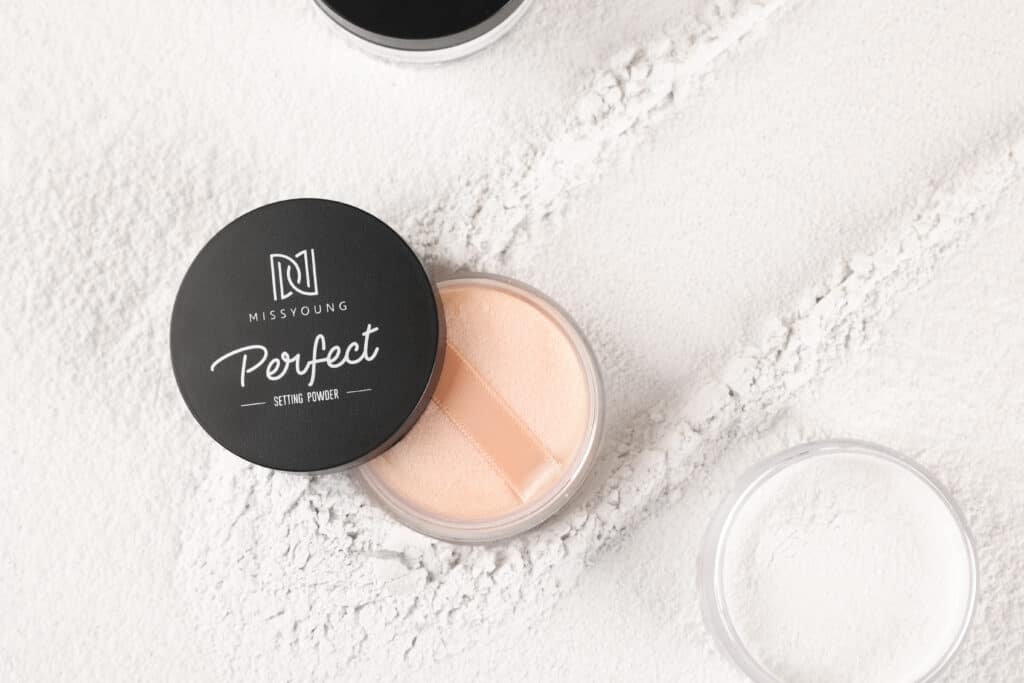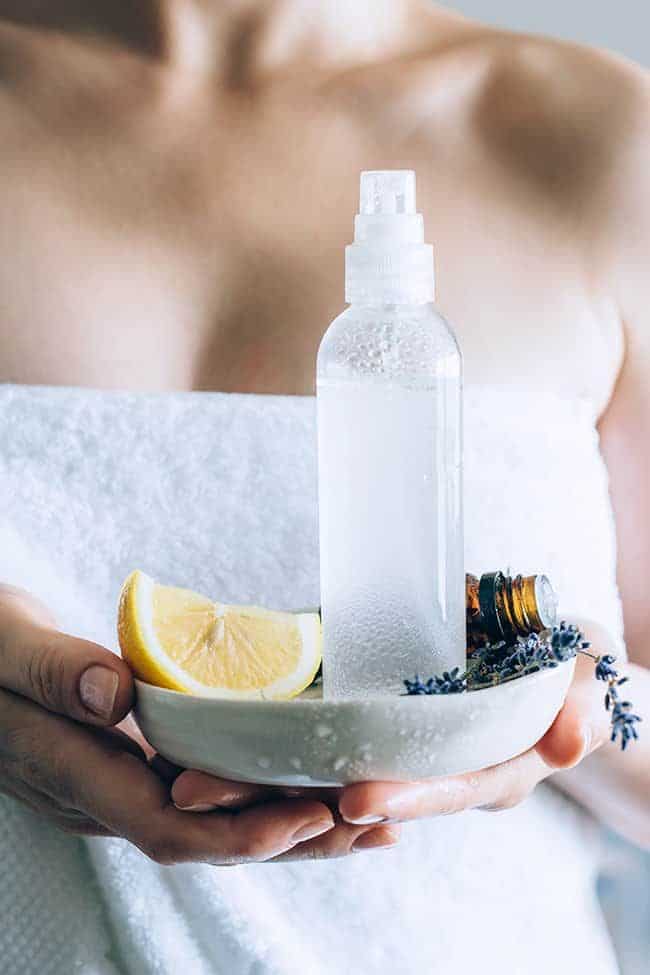Lead in
Are you looking for some guidelines on how to use a setting powder? Or are you already using one and have been told that it is an unnecessary step?
We have compiled a complete guideline for setting powders that might be useful for you to know the benefits and need to use a setting powder.
Let’s explore the advantages, functions, and differences between the different setting powders so you can decide if it is right for you.

What Is a Setting Powder?
A beauty product that sets the makeup in place is known as setting powder. It can be applied after foundation, concealer, or any form of foundation (cream or liquid).
A setting powder sets the foundation by giving a smooth finish to the blemishes and fine lines. It helps to control shine after the makeup application.
Setting powder is an invisible makeup step. But the fact is that a setting powder result can be seen visibly. It provides a flawless finish to the makeup.
The Function of Setting Powder
The basic function of the setting powder is to set the makeup for a longer time. Below are the functions of setting powder to provide:
Finishing
Setting powder finishes the makeup by setting it for a longer time. Your makeup will not need frequent touch-ups throughout the day. It helps to fade away any left blemishes after foundation application.
It keeps the concealer to stay in place. The concealer helps cover the under-eye area, whereas applying setting powder on the concealer can brighten up the dark circles.
Mattifying
The power to control shine by setting powder is what makes it special. It helps reduce excess oil on the face and is suitable for people with oily skin. A setting powder contains talc. Therefore, setting powder keeps all the benefits of talc.
Also, people with dry skin can use a setting powder to get a finished look. They can apply setting spray at the end of the makeup to get dewy moisture to avoid a dry patchy look.
Smoothing
A setting powder minimizes the look of open pores, providing a smooth skin texture. It helps to reduce fine lines and blemishes look. The setting powder has silica that helps achieve a smooth look.
You can see a visible difference in makeup melting down from the face and creasing.

Setting Powder for Beginners
There are many ways that a setting powder can help you. For beginners, we will recommend some of the tips while buying it and also when you apply it.
- Always choose the color of the setting powder that matches your foundation. Or else buy a slightly lighter color of the powder.
- A very light shade of setting powder can make you look cakey.
- Before applying a setting powder, prep your skin properly. This article will discuss the right way to apply setting powder further. So, follow those steps to get better results.
- Notice the difference with or without the setting powder. You will love the results.
How to Apply Setting Powder
To get the best results for any product, you need to know the right way to apply that product. For that purpose, here are the steps that you can follow to apply setting powder the right way:
- First, prep your skin; for that reason, you need to wash your face nicely. Apply moisturizer, primer, or concealer, or if you want to contour, go for that step. After all your basic makeup steps, apply your foundation. Be sure to wait between steps and blend the product evenly on the face and neck.
- Before applying any other makeup, hold on! It’s time to apply your setting powder. As the foundation is still damp, you must quickly pour out the setting powder.
- Take an appropriate amount of powder. The tool you are using for setting powder application should be evenly coated. Tap off the excess product from your applicator.
- Apply a little amount of powder to get a velvety or dewy look. But if your skin is oily or you want a matte finish, apply a little heavier powder.
- Your main focus point should be your T-zone. This way, you can get a natural and seamless look.
- As you have already applied the concealer and foundation, you need to be more careful while applying the powder. Gently press and roll the powder to avoid messing up with the rest makeup applied. Use a brush for a lighter application.
- As you apply the setting powder, let the product sit on the face for 1-2 minutes. This step is known as baking. After 2 minutes, blend off the powder using a fluffy brush in circular motions.
- Now, if you get desired coverage, apply the rest of the makeup—the brush, highlighter, bronzer, eyeshadows, liner, etc.

Loose Powder or Pressed Powder. What’s the Difference?
The ultimate goal of using this powder is to prolong the makeup’s longevity and control the shine of the face. The basic difference between loose and pressed powder is the formula. The different kinds of setting powder are as follows:
Loose Powder
Loose powders are finely milled powder formulas. It helps to blur the skin and make the makeup stay for a longer time. It contains silica or cornstarch that helps absorb excess oil way more than pressed powders.
It is also a translucent powder that comes only in one shade for all skin types and shades. Suitable for people with oily skin. Also, it is surely a good-to-go product if you want light coverage.
You can apply the loose powder using a big fluffy brush.
Pressed Powder
The pressed powders formula is more pigmented than the loose powders. It is suitable where there is the low maintenance required. It comes in different color ranges, unlike loose powders. A pressed powder is a good choice if you want smoother and lighter coverage.
It is ideal for touch-ups and easy to apply while traveling. You can apply pressed powder using a makeup sponge, powder puff, or a fluffy brush.
It is suitable for people with dry skin because of its hydrating ingredients.
Finish Powder
Finishing powders are used after the setting powder to add a more blurry look. It helps to hide imperfections and control the shine. Some loose powders are known as finish powders. These powders smooth out fine lines and wrinkles on the face and soften the overall look. Celebrities mostly use finishing powders for screen appearances. Finish powder helps to minimize the pores. It contains silica and silicone-based formula that helps to provide light diffusing effect to the skin.

Setting Powder V.S. Setting Spray
Setting spray and setting powder both keep the foundation crease-free. So, what’s the difference? Here is the difference between these two:
The Advantages of Setting Powder
Setting powder is designed to absorb excess oil from the face. It prevents the makeup from melting and lasts the makeup for a longer time.
If you have cracking makeup or tend to have creasing problems, then setting powder is a great choice.
The Advantages of Setting Spray
On the other hand, a setting spray is applied after the whole makeup is done. It is a mist that is sprayed to make the makeup stay longer. Using this spray, you can have two different finishes, whether dewy or matte.
It doesn’t absorb into the pores as a powder does. It creates a light and refreshing effect.
A matte setting spray cannot provide the look that a setting powder does. It is best suitable for dry skin because it boosts skin hydration.
Is a Setting Powder Necessary?
Whether you need to wear a setting powder depends on your situation. There are factors that you should consider first. Your skin type, the makeup type you desire, and how long you want to hold your makeup.
Setting powder can be very effective for people with oily skin. And if you are wearing a liquid foundation, then setting powder can help to keep it in place.
You can skip this step if you get irritated due to the extra dry skin. Also, your normal skin type may not require a setting powder. But if you are wearing a full coverage foundation, then setting powder can help to stay put on the makeup for a longer period.
Conclusion
The combination of wet and dry beauty products can be applied layer after layer. It can provide a long-lasting effect. Foundations and concealers are wet products, whereas setting powder is dry. Setting powder can be applied in many other ways. A setting spray and setting powder can be applied together.
There are different results for different makeup looks. Choose your desired look and pick your products accordingly!

